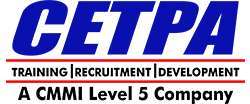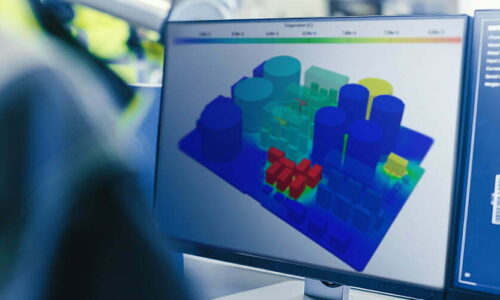Best Pro E Training Institute in delhi NCR

Join Best Creo Training in Delhi, Creo Training Course in Delhi, Creo Training Institute in Noida
WHAT IS CREO?
CETPA INFOTECH is the best PRO-E/CREO training institute in Delhi NCR.CREO is suite of software which provides 3D CAM/CAD/CAE software solutions. It was previously known as PRO ENGINEER. It was created by Parametric Technology Corporation (PTC) which supports product design for discreet manufacturers.It is the best pro-E/CREO training in Delhi NCR. The credit for marketing the feature based solid modeling software goes to PTC, as it was first to market the product. CREO supports the following features:
- Used for solid modeling.
- Used for assembly modeling and Drafting.
- Provides parametric and direct modeling.
- Used for finite element analysis.
In addition to these features it finds implications in various industries like:
- Finds application in Engineering Design.
- Helps in analysis of thermal, static, dynamic features which in turn helps to design the products.
- It consists of tools which execute manufacturing process of molding, die-casting and progressive tooling design.
HISTORY OF CREO
Samuel P Geisberg created PRO/E in mid 1980s. It was the first successful parametric 3D CAD modeling system. In order to get a good glimpse of the historical developments of the software, we will go through the timeline of the events.
- 1985 : Parametric Technology Company was founded.
- 1988 : PRO/E launched.
- 1992 : PRO/E was named as “Technology of the year” & caterpillar becomes the largest customer of PTC.
- 2002 : PRO/E Wildfire Released (it was the first Cad system to support web services).
- 2010 : “CREO elements/pro” launched.
- 2011-13 : CREO Parametric with various versions ranging from R1.0-R2.0 was launched.
INDUSTRY AND CAREER DEMANDS OF CREO (PRO/E)
Manufacturers using PRO/E have experienced certain rise in the productivity levels and faster time to market. In Industry, the concept engineering group uses the PRO/E software to design several workable components and their prototype before passing it to detail design team. The engineer simplifies the model to be designed before preprocessing with the help of PRO/E. It is in demand all over the world because of certain important reasons:
- It offers most robust functionality, with complete solution.
- It helps in creation of advance geometry.
- Manages assemblies on a large scale like that of companies like Boeing, Ferrari.
- Can produce “production ready drawings”.
The demand is immense; the only requirement is skills equipped with knowledge. For this, the students need to join CREO (PRO E) training. Thus, students must ensure to equip optimum knowledge and climb the ladders of success.
STEPS REQUIRED TO LEARN SYSTEM VERILOG
In order to command the CREO (PRO E) training, students can prefer to learn through certain proven steps. These are some of the proven strategies which can help students for “effective and smart learning”. Some of the steps mentioned below are:
- Basic knowledge of computers is required.
- Good Knowledge base in Design and modeling.
- Concepts related to TOM (Theory of Machines) should be clear and concise.
- There shouldn’t be any doubt in the concepts related to Engineering Graphics, Machine design as they form an integral part.
- Good analytical skills in implementing the concepts practically can turn a individual into a true expert professional.
STEPS TO LEARN CREO (PRO/E)
These are some of the proven strategies which can help students for “effective and smart learning”. Some of the steps mentioned below are:
- Basic knowledge of computers is required.
- Good Knowledge base in Design and modelling.
- Concepts related to TOM (Theory of Machines) should be clear and concise.
- There shouldn’t be any doubt in the concepts related to Engineering Graphics, Machine design as they form an integral part.
- Good analytical skills in implementing the concepts practically can turn a professional into a true expert professional.
EXPERTISE OF CETPA IN CREO (PRO/E)
CETPA being the specialized training school, provides international quality education to the Engineering students and other professionals, having training branch in cities like: Roorkee, Noida (Delhi-NCR), Lucknow, Dehradun and . Its innovative training methodology is set to establish a fostering mind-set that incorporates all elements of design and engineering to enhance candidate’s professional capabilities.
CETPA’s goal is to empower participants with knowledge and experience which results in an effective utilization of design knowledge ware. The faculty and staff at CETPA are committed to help the upcoming budding engineers towards finding their dream jobs through CREO (PRO E) training and building Professionalism. The comprehensive coverage of the topics is the reason behind its success. Important domains covered by the company in CREO (PRO E) training are:
- Mould designing, Die casting and progressive tool.
- Emphasis on high tech and innovative design.
- 3D modelling.
Each of the domains particularly “mould designing” & “die-casting” is covered with extensive exposure to practical skills with good attention from the expert trainers at each level of development. It is ensured that the students gain good knowledge in the application of the skills learned in designing. “Machine design and Engineering Graphics” is the important theme covered under this software and students are given rigorous training to hone their skills, and then student steps into 3D modelling to finally develop into true professional. Hence CETPA molds the student optimally.
The company believes in quality training and provide innovation friendly environment. Hence students should prefer joining the CREO (PRO E) training for 4/6 weeks or 6/10 months to develop into a true professional and meet the global standards.
COMPANIES USING CREO (PRO/E)
There are innumerable list of companies using CREO (Pro/E). The lists of diverse companies based on CREO (PRO/E) for the designing are:
- Honeywell
- Hyundai Powertech
- Microsoft
- Godrej and Boyce Manufacturing
- GE health care and more
The companies are from different industries like Airlines, Automotive, Aerospace, Medical industry, Electronics and High tech, Consumer products. All the major engineering industries use applications of CREO. CETPA offers CREO (PRO E) training that will assist learners to have the advance learning of technology after having basic knowledge as this will help them to grab best job opportunity with more attractive salary.
CETPA PLACEMENT RECORD
CETPA assists students in getting job placements on successful completion of their courses. It also provides recruitment assistance to organizations and guarantees 100% placements on completions. CETPA students are shortlisted based on the organization’s requirement. To make students job-ready, CETPA conducts workshops e.g. how to do Group Discussions, how to behave in a Personal Interview. From time to time, job fairs & campus recruitments are conducted. Workplace skills such as time management, technical learning, and advance learning of technology and communication skills are also provided. CETPA helps and succeeded in providing Indian as well as foreigner students find and grab appropriate jobs both nationally & globally. The students of CETPA get good opportunities to prove themselves in the placements. Some reflections of the placement can be observed in the table mentioned below:
CETPA trains student to be Industry ready and this is reflected in our placements. Students willing to bag a good and exciting career can join CETPA’s internship program or short term course for an exciting experience. For a countless number of placements from CETPA please Click Here.
What are the benefits of doing a Creo course?
- You will get better knowledge of programming and how to implement it for actual development requirements in the industrial projects and applications.
- Enhanced knowledge on the web development framework. Using this framework, you can develop dynamic websites swiftly.
- You will learn how to design, develop, test, support and deploy desktop, custom web, and mobile applications.
- Design and improve testing and maintenance activities and procedures.
- Design, implement and develop important applications in a Creo environment.
- Increased chances of working in leading software companies like Infosys, Wipro, Amazon, TCS, IBM and many more.
CERTIFICATiON
Professional growth, increased compensation and validation of the skill are the most popular reasons why individuals and professionals seek IT certifications. Keeping this in mind, we at CETPA provide you with certification in latest and innovative technologies to help you to reach your certification goals.
CETPA is the official Training partner of Oracle, Microsoft, Autodesk, Panasonic and Nuvoton and thus provides Training as per international standards and curriculum. CETPA proudly provides you certification in association with our training partners so that you can validate your domain specific technical skills. Certification from these big brands will help you in grabbing your dream job.
IMPORTANCE OF CETPA CERTIFICATION
For individuals and IT professionals:
- Gives you an advantage while searching for a job and provide a competitive advantage over your competitors.
- Ensure knowledge and skill are up to date and can be applied to the job
- Provide credibility to those looking for a career in an IT domain.
- Offer fast track to career advancement
- Demonstrate level of competency
- Professional Credibility as well as it demonstrates your dedication and motivation to professional development.
- You are likely to stand out from the crowd and be considered to be successful in your positions.
- Represent a well-recognized and valued IT credential that increases marketability and competitive edge.
For organizations:
- Provide peace of mind with the confidence that certified employees have truly learned the skills necessary to do their jobs;
- Express valuable credentials to search for in prospective employees, and can help retain top performers when offered as an incentive;
- Offer a competitive advantage when the team is trained and certified regularly.
FAQ
CREO (PRO/E) FOUNDATION TRAINING
INTRODUCTION OF DESIGN CONCEPT AND PROCEDURE
- Detailed Concept Of Cad
- Need & Importance Of Cad
- Overview About Actual Designing In Industries, Fundamentals Of Design And Its Implementation Methods
- All Characteristics Of Creo (Pro/E) To User Friendly Atmosphere
- Superiority Of Creo (Pro/E) With Its Use And Demand In Industries
INTERFACE WITH GUI
- Menu Manager
- View Toolbar
- Controlling The View
- Model Display
- Datum Display Toolbar
- Working With Document
- File Tools
- System Colors
- Selecting The Entities
- Working With Mouse Button
- Selecting The Working Directory For Saving The Document
- Model Tree
- Pro-E Help Option
- Document In Session
- Set The Parameter
SKETCHER
- Sketcher Diagnostics Tools
- Creating The Vector Shapes
- Working With Grids
- Snap Mode
- Creating The Coordinate
- Creating Spline And Its Geometry Control
- Display Dimension
- Work With Weak And Strong Dimension
- Edit Definition
- Creating Axis For Reference
- Work With Geometrical And Dimensional Constraint
- Insert Design From Palette
- Creating Text
- Import Data From Dxf. File
- Deleting And Trimming The Sketch Entities
- Analyze The Sketch For Opening Edges
- Modifying The Design
BASE FEATUES OF PART DESIGNING
- Creating Solid Geometry
- Selecting The Part Environment
- Selecting Datum Planes (Top, Front, Right)
- Creation Of Sketch For Solid Modeling
- Converting An Area Into Volume Using Extrude Features
- Define The Limits Of Extrusion And Its Controls
- Remove The Cavity From The Solid Part
- Creating Revolute Design
- Cut Out Part By Revolute
- Sweep Feature
- Protrusion
- Thin Protrusion
- Cut Sweep
- Surfaces
- Blend Features
- Parallel Blend
- Rotational Blend
- Blend Surfaces
- Create Solid Profile Using Swept Blend Features
- Creating Spring By Helical Sweep
- Boundary Blend
- Creating Axis And Points
- Generate New Datum Planes
- Creating Datum Curves
EDITING FEATURES OF PART DESIGNING
- Mirroring Features
- Moving Features
- Suppressing Features
- Copying Features
- Deleting Features
- Patterning Features
ENGINEERING FEATURES OF PART DESIGNING
- Create Draft
- Constant Angle Draft
- Variable Angle Draft
- Creating Drill Hole
- Rib Features
- Create A Shell Body
- Creating Round And Corners
SETUP & UTILITIES
- Select The Material
- Specify The Accuracy
- Mass Properties
- Setting The Pro/E Environment
ASSEMBLY MODELING
- Top Down Assembly
- Bottom Up Assembly
- Inserting The Component Into Assembly
- Create A New Component In Assembly
- Placing &Replacing The Component
- Defining Assembly Constraint
- Define Mating Between Parts
- Create Align Constraint
- Define Tangency
- Define Point On Line &Surface
- Automatic Constraint
- Fix The Part
- Create Multiple Copies Of Parts In Assembly
- Flexible Component
- Edit Constraint Definition
- Patterning
- Change The Order Of Component
- Deleting Component
- Explode The Assembly Creating Bill Of Material (BOM)
TDRAFTING (DETAILING)
- Introduction Of Drafting
- Need & Importance Of Drafting
- Starting The Drafting Workbench
- Defining The Sheet & Sizes
- Adjusting Of Drawing Sheet According To Object/Assembly
- Types Of Projection
- Using Predefined Drafting Styles
- Scaling The Drafted View
GENERATIVE DRAFTING
- What Is Detailing?
- Setting Up And Configuring Drawings
- Using Drawing Tree, Layers, And Drawing Parameters
- Creating Drawings
- Adding Models To Drawings
- Creating The Drawing Layout
- Using Model Grids
- Inserting OLE Objects
- Importing Draft Data From External Applications
- Working With Drawing Tables
- Creating Drawing Tables
- Generate Report For Drawing
- Using BOM Balloons
- Add Dimension In The Drawing
- Create A Detail View
- Working With Dimension Display
INTERACTIVE DRAFTING
- Sketching In Drawing Mode
- Drafting In Drawing Mode
- Working With Draft Cross Sections
- Relating Detail Objects
- Grouping Detail Objects
- Reviewing And Publishing Drawings
- Reviewing Drawings
- Comparing Drawings
- Publishing Drawings
- Exporting Drawings To A Pdf Format
- Exporting Drawings To Other Formats
- Using Drawing Representations And Programs
- Working With Drawing Representations
- Creating Drawing Programs
DATA EXCHANGE
- Converting Files For Transferring
- Converting Into IGES, STEP,PARASOLID Etc.
- Convert Into Jpeg, Mpeg, Tiff, Pdf Files
SHEET-METAL DESIGNING
INTRODUCTION TO THE CREO SHEET-METAL DESIGN PROCESS
- Creo Sheet-Metal Design Process
SHEET-METAL MODEL FUNDAMENTALS
- Sheet-Metal Model Fundamentals
- Understanding Developed Length
- Creating a New Sheet-Metal Part in Assembly Mode
- Creating a New Sheet-Metal Model in Part Mode
- Converting a Solid Model to a Sheet-Metal Model
CREATING PRIMARY SHEET-METAL WALL FEATURES
- Understanding Sheet-Metal Wall Features
- Creating Flat Walls
- Extruded Sheet-Metal Wall Features
- Revolved Sheet-Metal Wall Features
- Sheet-Metal Wall Sketching Tools
CREATING SHEET-METAL SECONDARY WALL FEATURES
- Understanding Secondary Walls
- Creating Secondary Flat Walls Using Flange Walls
- Using Extruded Walls
- Wall Dashboard Options
- Understanding Relief
MODIFYING SHEET-METAL MODELS
- Bends
- Bend Options
- Unbend Features
- Bend Back Features
- Flat Pattern
- Sheet-Metal Cuts
- Die Form Features
- Punch Form Features
- Rip
SHEET-METAL BENDS AND SETTING UP THE SHEET-METAL ENVIRONMENT
- Order of Bend Features
- Fixed Geometry
- Flat States
SURFACE DESIGNING
SURFACE MODELING OVERVIEW
- Introduction to Surfacing
- Surface Modeling Uses
- Surface Modeling Paradigms
- Freeform Overview
- Blending Surface Modeling Paradigms
- Surfacing Terms
ADVANCED SELECTION
- Advanced Chain Selection
- Advanced Surface Selection
BASIC SURFACING TOOLS
- Creating Surface Extrude Features
- Creating Surface Revolve Features
- Creating Fill Surfaces
- Creating Sweep Surfaces with Open Trajectories
- Creating Parallel Blend Surfaces
- Creating General Blend Surfaces
HELICAL SWEEPS
- Understanding Helical Sweeps Theory
- Utilizing Helical Sweeps for Surfaces
CREATING AND EDITING SOLIDS USING QUILTS
- Thickening Surface Quilts
- Solidifying Quilts to Add Material
- Solidifying Quilts to Remove Material
- Solidifying Quilts to Replace Material
- Offsetting Surfaces using the Replace Option
Mode/Schedule of Training:
CETPA, The Best Creo Training Institute in Delhi NCR offers courses in following modes.| Delivery Mode | Location | Course Duration | Schedule (New Batch Starting) |
|---|---|---|---|
| Classroom Training (Regular/ Weekend Batch) | *Noida/ Lucknow *Dehradun /Roorkee | 4/6/12/24 weeks | New Batch Wednesday/ Saturday |
| *Instructor -Led Online Training | Online | 40/60 Hours | Every Saturday or as per the need |
| *Virtual Online Training | Online | 40/60 Hours | 24x7 Anytime |
| College Campus Training | India or Abroad | 40/60 Hours | As per Client’s need |
| Corporate Training (Fly a Trainer) | Training in India or Abroad | As per need | Customized Course Schedule |
5

Pro E Training in Noida
The course training is very good. The trainers are very experienced and skilled.
Pro E Training in Noida
The course training is very good. The trainers are very experienced and skilled.
Course Features
- Lectures 0
- Quizzes 0
- Duration 10 weeks
- Skill level All levels
- Students 0
- Assessments Yes







